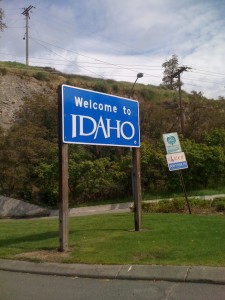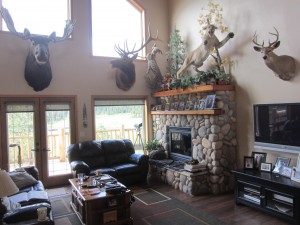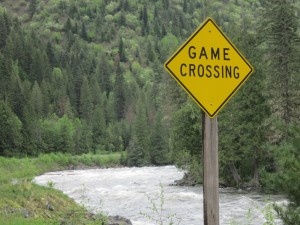
A subtle shift happens as we leave eastern Washington and cross into Idaho. Cowboy boots begin to appear. Cowboy hats. Large belt buckles. Stuffed animal heads decorate roadside eateries. We’ve left the coast far behind, and are in new territory.
And then there are the radio stations. On some lonely stretches of road we only get one or two stations, invariably AM talk radio. We listen to a man named Lars Larson, a conservative right-wing host, who pisses me off so badly in about 10 minutes I turn the radio off. I’m bothered to say I can’t recall the topic.
Later we try again and discover the Sean Hannity radio show, another conservative host. He is an articulate, intelligent guy, and doesn’t take any guff from a caller who calls to rant about the legitimacy of Israel, and he defends homeless people to another caller who complains their presence is harming his business.
We don’t listen to much radio at home. A little NPR, and some Pandora. It is uncomfortable (and interesting to notice our discomfort) to have our world view shifted in this direction. It reminds me of a Ted talk by Eli Pariser, where he discusses online filtering by sites like Facebook and Google, and how filtering based on algorithms can lead to a self-reinforcing world view. Essentially, you only see information curated for you based on what you like/click, so that other points of view don’t even show up in your results anymore. If these radio stations were websites, I doubt they’d get through our filters.
Traveling shifts your world view. In many ways, these 17 months have been an extended course in world history and “how the world works”. Our lessons continue as we wind our way through Idaho, on our way to Mark’s Aunt Carolyn and Uncle Bob’s house.
Bob and Carolyn live outside New Meadows, a small town of about 500 people. Passing through town, it is clear to us that its heyday is past. Most of the stores and restaurants along the main street are boarded up, and there’s a patina of dust and neglect that suggests the good ole’ days came and went some time ago.
They live in a beautiful log house, located on a dirt road about five miles outside town. Bob and Carolyn greet us warmly, and we enter the house. Inside is a menagerie of North American wildlife – stuffed, skinned and mounted on all the walls. There is a moose, several deer, a mountain lion, a bob cat, two bears, a raccoon, several birds, a giant trout. We knew Bob was a hunter, but the scope of the display catches me unaware. The first thing I ask, “Do they have names?”

A partial view of the menagerie, with Bullwinkle on the left
D’oh, wrong question. One does have a name – the moose – AKA Bullwinkle, a former resident of Alaska. This was an unusual situation for us. Neither of us hunt, and I haven’t fished in years, since a fishing excursion near San Felipe, Mexico. (We were fishing for snapper, but I caught a 2.5 foot sand shark, a gorgeous iridescent gold and pink fish. I thought we would throw it back, but the captain swung it like a baseball bat against the side of the boat. Thwack! Thus marked the end of my very limited fishing career.)
A few months after that incident I became a vegetarian, and remained so until about a month before we left for our travels. There are other reasons I went veggie too, mostly to do with the treatment of animals raised for meat in the U.S., which I won’t delve into here. I jokingly referred to this travel time as my “meatcation”, as it would have been very difficult to not eat meat in some of the places we traveled.
As to shifting our world view through new experiences – I want to keep an open mind. So I ask lots of questions. And learn a lot. In Idaho, there are limited hunting seasons and quotas for animals. Most of the meat Bob and Carolyn eat is what they hunt. They buy very little beef or chicken, mostly for guests who don’t like wild game. Even the bear – an animal known for greasy meat – is used to make salami and pepperoni. They freeze, can, or smoke/dry their kills.
There’s a lot of marketing in more liberal, affluent parts of the country right now about the importance of buying local produce, and supporting “humanely raised” meat farms. Whole Foods is implementing a meat rating system that tells consumers more about how their meat was raised and treated (I find it disturbing that it isn’t until Step 5 that “animals get to live their whole lives with all the parts they were born with”).
Rural Idaho takes things to a whole different level – where you hunt, clean, and eat your kill. The game is wild, so the animals haven’t suffered the terrible conditions many animals endure on commercial farms. Aside from eating meat grown in a petri dish, insects, or salvaging road kill, this lifestyle strikes me as one of the more ethical ways to get animal protein.
Living in relative isolation requires you to be more independent. You’ve got to be pretty self-sufficient to thrive in rural Idaho, where the nearest Costco is a two hour drive. If someone tries to break into your house, the nearest sheriff is probably at least 30 minutes away. You need to be able to defend yourself. I begin to understand why some people feel so strongly about the right to bear arms and support the NRA.
The mindset around wild animals is different too. Road signs in California, Oregon and Washington read “Wildlife Crossing”. In Idaho, they say “Game Crossing”. Wild life is something you view and conserve; game is something you hunt and eat.
Next stop: Montana.

{ 2 comments… read them below or add one }
30 min for a sheriff? That’s fast swan valley has one if he’s on a call try 90 min. However the biggest threat to the peace of Montana is the federales or them Kalifornyians. Hanity is a conservative? I thought he was from New York?
Ahem…isn’t this the pot calling the kettle black, Mr. Kalifornyain? ;^) Giuliani is from NY – you telling me he’s a liberal?!?